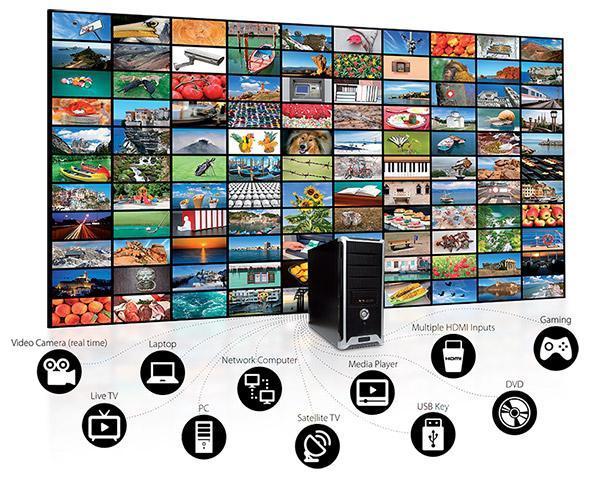3 Options for Choosing Video Wall Processors
The Leading Provider of AV as a Service (AVaaS)

While there are many video wall processors to choose from, they vary widely by cost and complexity. For those looking to use video wall processors to power their video walls, this article will cover the major trends in video wall processors and highlight some key considerations.
Three Main Video Wall Processor Options
There are three main types of video wall processors, each with a different approach.
- Proprietary hardware (a “Black box”) with fixed inputs and outputs
- A PC chassis with added video cards
- Network-delivered-video wall processors use a standard PC but don’t require video cards
Let's take a look at all three.
Option 1: Proprietary Hardware
Proprietary server hardware with fixed inputs and outputs is the most common approach to video wall processors used by Planar Matrix, tvOne CORIOMaster, RGB Spectrum Galileo, Extron Quantum Elite, Christie Digital.
Benefits
The benefit of this approach is that the hardware comes pretested and preconfigured for a specific load and use case.
Drawbacks
The challenge is that with proprietary hardware, customers pay a significant premium for the product and should a replacement or service be required in an emergency the customer may have limited options. This approach is also not scalable.
If you want to change the number of inputs or outputs you'll likely need to buy entirely new hardware.
Option 2: PC Chassis With Video Cards
The second approach to video wall processors is add-on video cards. Take a PC chassis and insert video cards that output content directly to the displays.
Benefits
This approach is championed by companies like Matrox and allows a system integrator to turn a PC into a video wall processor.
Drawbacks
This requires system integrators to match a PC and its motherboard to the number of video cards required and to add on software to process the content.
Depending on the hardware used, this can be an expensive upfront cost, but more importantly, as with proprietary hardware, using video cards limits future growth and capacity and is limited to the capabilities (in terms of content size, display rotation etc) of the video cards used.
Option 3: Network-based Video Wall Processor
The third approach is the network-based video wall processor (that uses a standard-off-the-shelf PC, software, and the network. This solution was developed by Userful, and addresses the fundamental challenge other processors face: lack of flexibility and the inability to change and grow with the customer.
Benefits
Userful software installs on a standard off-the-shelf PC (from HP or Lenovo) and uses standard low-cost zero clients at each display, connected to the PC over the network.
Because a standard PC can deploy from 1 to 60 screens and can do up to 8k source content, the solution is as scalable as customers required. As well, since a network-based solution depends on software for its functionality, customers can take advantage of new features and functionality more quickly and easily.
In conclusion
While video cards and proprietary software offer a convenient solution for video walls, both of these approaches share one important flaw: they are hardware-based solutions and a customer is buying a solution with little future growth and at risk of making a very large investment only to find that as their business needs change, the video wall processor is incapable of growing and changing with their needs.
With a network-based solution for video walls, you are never constrained when your needs change and will save money over time.
Read more about how to use Userful as a video wall processor, and check out our video wall processor FAQ. As always, make sure to join our mailing list to get more tips on video walls and solutions.
Userful
The Leading Provider of AV as a Service (AVaaS)